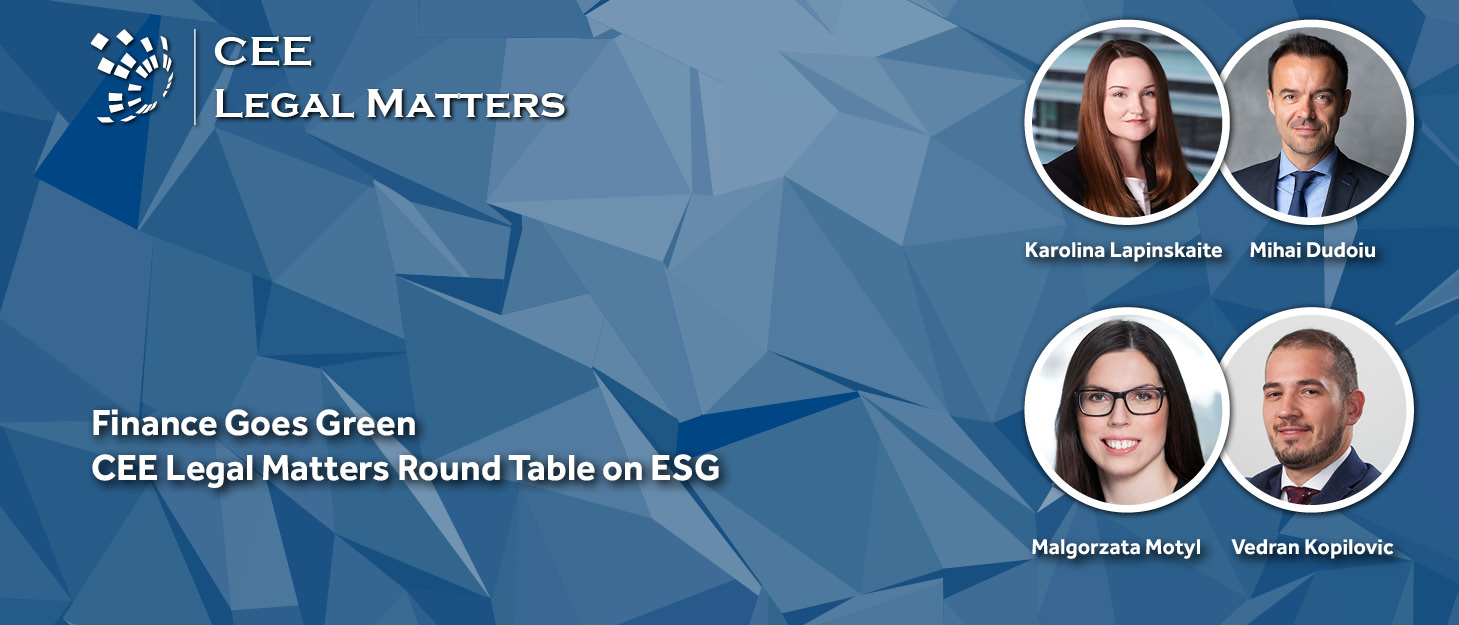On July 12, four leading lawyers from Croatia, Lithuania, Poland, and Romania sat down for a virtual round table moderated by CEE Legal Matters Managing Editor Radu Cotarcea to discuss the latest in ESG developments with a focus on green financing, its regional and local drivers and roadblocks, its impact on non-financial reporting, and what it all means for the legal profession.
Participants:
- Karolina Lapinskaite, Senior Associate, TGS Baltic
- Malgorzata Motyl, Senior Associate, Penteris
- Mihai Dudoiu, Partner, Tuca Zbarcea & Associatii
- Vedran Kopilovic, Senior Associate, Kinstellar
You can also listen to the conversation as a podcast below.
CEELM: How green would you assess finance to be in your jurisdiction at the moment? Where do you see it five years from now?
“Croatia has a legislative framework securing a platform and structure for green financing,” Kopilovic begins. “We have an accountancy act that transposes the most relevant directives – on financial reporting and the Sustainable Finance Disclosure Regulation – for market participants and financial advisors.” While the legal framework is solid on paper, he says that, particularly in the last few months, “the reality of inflation, the war in Ukraine, and even the pandemic have created setbacks.”
Still, there has been some progress, he reports, “and a certain amount of sustainability-linked loans were offered by commercial banks in Croatia, closely linked to ESG factors. And the Croatian Bank for Reconstruction and Development has also initiated a green financing program for entrepreneurs.”
In the next few years, looking past the recent setbacks, Kopilovic expects things to develop, “particularly with the new directives and EU green bond standards, which would mean additional focus on green financing and the green bond market.”
The situation in Romania is not much different, Dudoiu reports: “On paper, it looks green enough, with everyone talking about, and being interested in, green financing. Big players – the larger commercial banks and the authorities – have issued programs and statements, but things are still incipient, to a large extent.” He says that Raiffeisen and Erste’s BCR have issued green bonds but, “compared to the size of the market, it’s still a tiny level of activity.”
As for banking and finance, Dudoiu says loans have also seen some interest, having worked with the banks on “a couple of green loan transactions” and putting out “some offers for financing for energy projects – to be probably resolved as green loans.” Overall, he stresses that “things are just starting to move,” with the “expectation to see this growing – a lot – in the following years, across multiple industries: from real estate, where larger and residential buildings have a big impact on the environment and energy consumption, to renewables, to plastics (where we’ve done our first green loan last year), and paper manufacturers (an ongoing project, for green facilities in a larger structure).”
He's also optimistic that the trend will pick up speed – “despite the concerns over inflation, recession, the pandemic, or the war – as there is also regulatory pressure supporting it.”
Poland, on the other hand, is “not as green as it seemed a few months ago,” according to Motyl, “as 2021 financial statements were the first ever to have regulatory requirements on ESG.” She says that “many companies found out on the day of release that they needed that extra data. The topic of ESG reporting is quite new, and even the larger companies were unaware of the new requirements on ESG issues – this being the first example to describe the situation in Poland.”
“Then, there’s the banks’ attitude – it’s a very complicated time for the banking sector right now, with growing inflation, less liquidity, and regulatory changes – so banks are very cautious on loans for companies or entrepreneurs and even on mortgage loans,” Motyl continues.
But it’s a confusing time all-around, she notes: “In order to reduce dependence on Russian fossil fuels we’re going back to coal, looking into nuclear, and trying to promote green energy. There’s legislation in the works on financing for green projects and renewable energy – so a lot of back and forth, trying to repair the damage done in 2016 to the wind and solar industry.” Still, that means “a huge change is coming,” she says, with energy independence the end goal and green thinking the way to reach it.
To no one’s surprise, Lapinskaite says Lithuania is quite active in green finance. Yet “the current level of capital being raised for such investments is not sufficient in the long term,” she believes. There were large green financing transactions in the country, even before the ESG regulations: “Lithuania was well known for its multi-apartment renovation program, aiming to reduce greenhouse gas emissions. And also, we had some green bond issuances under the International Capital Markets Association green bond standard. More recently, the country had its debut sustainability-linked bond issuance, also a Baltic first.”
“Currently, financial market participants are starting to introduce green financing possibilities, like green guarantees,” Lapinskaite notes, but a lot still has to be done. “Half a year ago, Lithuania introduced the sustainable finance action plan, aiming to become the regional hub for sustainable finance – through, for example, the establishment of a sustainability database – as complete and accessible data is essential in assessing the compliance of companies with ESG criteria.”
In five years’ time, she believes that such “local initiatives, especially targeted to SMEs, and the EU-level regulations will help with the plan’s implementation, to make green financing in Lithuania an even more frequent and common sight.”
CEELM: It’s obviously a common denominator to look at a top-down approach – especially looking at EU Directives and Regulations – but there is considerable difference between the market realities. What have been the largest drivers?
“Regulation is indeed playing the key role in driving green financing,” Lapinskaite says, noting that “businesses need to decide if they will implement the changes and take advantage of the opportunities, or take the risk of being left behind.” For the banking sector, she says “the same regulatory requirements will push the banks towards more green financing, so they will need to include those ESG assessments in their risk management system and publish reports about the extent to which their balance sheets support economic activities that substantially contribute to reaching the EU net-zero targets.”
Agreeing on the incentives, Dudoiu says “the EU remains a big factor.” The larger Romanian banks are mostly part of EU financial groups. So, “their policies at the group level are coming to Romania – they were the first to come to market with such programs, implemented by local subsidiaries,” he notes. Banca Transilvania – a local player – “will probably follow suit soon, as they need to protect their market share.” He expects that, “once the lending starts and the image is building, others will join in, reinforcing the energy of the movement, because of branding and public perception needs.”
Another factor, Dudoiu notes, is the EBRD and other IFIs, “making facilities available for commercial banks that will, in turn, on-lend to residential and commercial projects and local authorities for green projects and ESG in general.”
Adding to what was said, Kopilovic notes that “the driver for the green transition, in theory, should be the goal of having a sustainable circular economy. But that’s not the reality. The major driver is still the better green financing terms available. And companies caring about their green reputation – investing in sustainable technologies – to attract capital market investors.”
For Poland, it’s (geo)politics first. “We have elections next year,” Motyl stresses, “the most important election since 1989.” So, the country is focusing on internal matters instead of EU challenges. “Sadly, all the green initiatives are coming from the EU, she says, resulting from EU legislation and requirements.” The government (and probably future ones) will be “focusing on developing nuclear power plants,” she says, “which, as a huge infrastructure project, may play a role in developing green financing as well.”
She highlights there are “only two commercial banks focusing on green issues, with a portfolio to match. They support green projects and energy, and environmental sustainability – but that’s still only two banks in the whole country.”
CEELM: What particular roadblocks is your jurisdiction facing?
For Lapinskaite, the biggest roadblock to implementation is “the lack of understanding about ESG requirements, especially among corporates which are not directly compelled under the Taxonomy or the NFRD, as well as the lack of data to calculate taxonomy alignment.”
Dudoiu says “it takes time to absorb it all – the Taxonomy is complicated and, while the principles are clear, there is some resistance to the novelty. But that’s where we come in – as consultants we educate ourselves and then pass on our knowledge to clients.”
Kopilovic agrees the Taxonomy is a roadblock, “being too complicated and still needing interpretation to get some clear standards.” Most companies in Croatia are making a big effort, he says, and incurring a lot of costs, just to stay up to date and remain compliant on ESG: “it is exhausting for their legal and financing teams. Maybe if it were all simpler, companies that are not legally required to would also file those reports.”
Motyl circles back to politics as the biggest roadblock for Poland. “2023 will be a big challenge, for the country and the voters. We’ll be deciding for the future, not only on green issues, but our future within the EU as well.”
CEELM: Looking at the level of progress that has been achieved – despite the slow speed or any blockages – in terms of greening up financing flows: Where do you see more progress? Was it banks or capital markets, and why do you think that was?
Dudoiu points out it was actually the banks of both fronts in Romania: “Banks were the first to issue and list green bonds (BCR Erste, Raiffeisen) and first on loans as well. They are trying to make products available for clients, and educate them with incentives and better margins, and explaining their conditions for green loans. So, going through the financial system, and the banks in particular, remains an important tool – both IFIs and commercial banks are doing a good job and were the first to react.”
Kopilovic joins in, saying that’s also the case in Croatia, with the banks as major players in green financing. “They have green financing products and green share or bonds portfolios. If you look at any green financing in the country, you’ll find the banks there – also some broker companies focusing on green investment and financing programs – but those seem to be much smaller in scale.”
For Lithuania the difference isn’t that large between banks and capital markets, Lapinskaite says, but “there’s bigger publicity about the capital markets. And the Lithuanian energy sector was quite active – issuing green bonds previously – and issuing sustainability-linked bonds recently.” Speaking about the volumes, she says capital markets probably lead the field, but there are also some “large banking financing transactions, especially with support from the EBRD, EIB, and other institutional investors.”
“Banks still have a priority role in Poland, providing green financing for companies interested in introducing green business solutions,” Motyl points out. But she finds the capital markets more interesting: “Some private investment funds describe themselves as very ESG compliant. Even three or four years ago we had investors pulling out of deals on environmental grounds. So, while banks may be more active on volume, private investors are more aware of ESG issues and discerning. So, the change is starting from private investors, holding potential target companies to a high standard.”
CEELM: Just how active have companies become in reporting on ESG to date?
ESG reporting is not widely known right now, Motyl says. “Last year’s requirements were a surprise, catching companies unaware. We’ll need to specify the criteria for such reporting, as they’re either unclear or nonexistent. Everyone just wrote whatever they wanted, and we ended up with junk data. So, we’ll need to standardize reporting for the whole market first, to then be able to focus on analyzing the reported data.” In the end, she says it all needs to be “useful as one of the factors considered when evaluating the worth of the company.”
It's all incipient, Dudoiu says. “But we’ve seen projects, especially on real estate, where the advertised green projects were just marketing and no substance.” While other players were taking things very seriously: “at a conference last year, one of the biggest real estate investors in Romania, investing millions and millions in the green aspect of their projects, expressed frustration at rampant greenwashing.” Still, he says in the long run things should course-correct, with “banks having filters on both project selection and implementation, and only associating with real projects. So, things will become more rigorous, for the larger projects at least.” And those not taking things seriously “will suffer in the long run.”
That’s partially true for Croatia as well. There is some progress in that regard, Kopilovic says, citing data for the past few years showing that “40% of the companies that published non-financial reporting weren’t required to do so.” So, they see the opportunity to encourage a sustainable way of business – and to promote themselves and attract investors, he notes. As for the banks and how they look into ESG reporting for green financing, he says that, “for sustainability-linked loans, they are required to do so, and they should have strict criteria. It might not always happen, but much more attention will be paid in the future.”
In Lithuania, listed companies and large corporations are the ones currently preparing ESG reports, Lapinskaite says. “Other companies prepare such reports on a need-to basis, in case they need to attract funding from institutional investors, for example. Usually, the banks are providing their clients with some ESG due-diligence questionnaires, to better understand underlying ESG risk and for the banks’ internal scoring and risk assessment.”
CEELM: And what was the impact of the Taxonomy on reporting? Has it helped so far? Has it clarified any ambiguities your clients were facing on ESG reporting?
The Taxonomy will help to improve the quality of such ESG reporting, Lapinskaite continues. “The requirement for the banks to disclose their green loans, bonds, and other exposures – in order to claim that their balance is green, and how green – they will need to gather such data from their clients, so this will substantially contribute to ESG reporting.”
It was a necessary starting point, for everyone to speak the same language, Dudoiu says. “To have some definitions and concepts to operate with. But the regulations are still complicated – and banks might be overwhelmed with all sorts of regulations. But the process will settle in, and I suspect the banks will start building departments specializing in green financing. They will become more and more familiar with the issues, and things will start to flow.” And the same can be said for the advisors as well, in his opinion: “the first green loan might be harder, but once you’ve done ten, you’re a natural. There’s still some effort to digest ongoing.”
For Kopilovic, the Taxonomy is a great classification tool, “to allow all participants to reach a standardized form of reporting. And it’s good for the government and the regulator to provide these participants with the right way in developing and investing funds – to encourage a sustainable circular economy.”
CEELM: What do you assume the impact of ESG is on the role of lawyers?
“As external advisors, we are exposed to multiple projects from multiple clients,” Dudoiu notes. “So, we have the chance to, and must, educate ourselves. We then pass on whatever legal information and insight, and we can help of course, by doing research and looking into specific future legislation, as things are being implemented. To give clients time to adapt, in an ideal world.”
“Legal advisors are also participants in the system,” Kopilovic highlights. First of all, “lawyers should be the ones educating and providing any assistance to the client, when required, on ESG compliance. And they should also take care that clients are aware of their obligations to have non-financial reporting and any benefits that may apply.”
CEELM: Name one wish list item that would help promote ESG in financing:
Lapinskaite notes that the “progress at the EU level is very welcome,” and she looks forward to seeing “better recognition of investments for intermediary steps on the path towards sustainability. This is necessary since usually financing for the transition is needed in most economies.”
“We should reshape our thinking about the world and environment,” Motyl says. “To believe that this legislation has a wider goal: taking care of our economy and our world. Green financing and products are making our world better – so implementing them not because of the requirements, but because it’s the right thing to do.”
“We need balance between things being forced on people and those people believing in what they do,” Dudoiu says. “Too much regulation may become counterproductive – but left to the free market, the system doesn’t have enough energy to make things move as far as they need to.” So, the regulations side is doing well, he concludes, “those should not be overcooked. And then it’s up to society and the system to put in the effort and digest. There will slowly be more incentives as well as requirements, and the system will develop and amplify the movement. I’m quite interested to work on these projects – not just for the fees, but because we all need it.”
For Kopilovic, the top wish is also for people to start “reshaping their thinking in terms of the positive impacts of a sustainable economy and green financing.” And on the legal side, what’s needed is “for companies and other undertakings active on the market to have some level of compliance with ESG requirements. And then stricter rules for financing and clear criteria that must be met in order to access funds.”
“It’s no good to push people or companies to go green. We should rather incentivize them into changing their way of doing business, by using the available legal framework and tools,” he concludes.
This Article was originally published in Issue 9.7 of the CEE Legal Matters Magazine. If you would like to receive a hard copy of the magazine, you can subscribe here.













